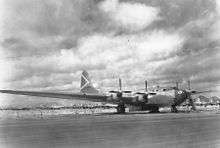Douglas XB-19
The Douglas XB-19 was the largest bomber aircraft built for the United States Army Air Forces until 1946. It was originally given the designation XBLR-2 (XBLR denoting "Experimental Bomber Long Range").
| XB-19 | |
|---|---|
.jpg) | |
| Role | Heavy bomber |
| National origin | United States |
| Manufacturer | Douglas Aircraft Company |
| First flight | 27 June 1941 |
| Retired | 17 August 1946 |
| Status | Scrapped |
| Primary user | United States Army Air Corps |
| Number built | 1 |
Design and development
The XB-19 project was intended to test flight characteristics and design techniques for giant bombers. Despite advances in technology that made the XB-19 obsolete before it was completed, the Army Air Corps believed the prototype would be useful for testing despite Douglas Aircraft wanting to cancel the expensive project. Its construction took so long that competition for the contracts to make the XB-35 and XB-36 occurred two months before its first flight.
The plane first flew on 27 June 1941, more than three years after the construction contract was awarded. In 1943 the Wright R-3350 engines were replaced with Allison V-3420-11 V engines. After completion of testing the XB-19 was earmarked for conversion into a cargo aircraft, but modifications were not completed, and the aircraft flew for the last time on August 17, 1946. It was eventually scrapped at Tucson in June 1949.[1][2]
Surviving artifacts

The new U.S. Air Force had plans to save the B-19 for eventual display, but in 1949 the Air Force did not have a program to save historic aircraft and the Air Force Museum had not yet been built. The B-19 was therefore scrapped, but two of its enormous main tires were saved. One was put on display at the Hill Aerospace Museum at Hill Air Force Base in Ogden, Utah and the other has been on display at the National Museum of the United States Air Force in Dayton, Ohio, in the "Early Years" gallery for many years.[3]
Specifications (XB-19)
Data from McDonnell Douglas aircraft since 1920 : Volume I[4]
General characteristics
- Crew: 16 combat crew, with provision for 2 additional flight mechanics and six-man relief crew
- Length: 132 ft 4 in (40.34 m)
- Wingspan: 212 ft 0 in (64.62 m)
- Height: 42 ft 0 in (12.80 m)
- Wing area: 4,285 sq ft (398.1 m2)
- Empty weight: 86,000 lb (39,009 kg)
- Gross weight: 140,000 lb (63,503 kg)
- Max takeoff weight: 162,000 lb (73,482 kg)
- Fuel capacity: 10,350 US gal (8,620 imp gal; 39,200 l) internals with optional auxiliary tanks of 824 US gal (686 imp gal; 3,120 l) capacity
- Powerplant: 4 × Wright R-3350-5 Duplex Cyclone 18-cylinder air-cooled radial piston engines, 2,000 hp (1,500 kW) each
- XB-19A Later fitted with 4x 2,600 hp (1,900 kW) Allison V-3420-11 24-cylinder engines
- Propellers: 3-bladed constant-speed metal propellers, 17 ft 0 in (5.18 m) diameter
Performance
- Maximum speed: 224 mph (360 km/h, 195 kn) at 15,700 ft (4,800 m)
- Cruise speed: 135 mph (217 km/h, 117 kn)
- Range: 5,200 mi (8,400 km, 4,500 nmi)
- Ferry range: 7,710 mi (12,410 km, 6,700 nmi) with auxiliary tanks fitted
- Service ceiling: 23,000 ft (7,000 m)
- Rate of climb: 650 ft/min (3.3 m/s)
- Wing loading: 32.6 lb/sq ft (159 kg/m2)
Armament
- Guns:
- 5 × 0.5 in (12.70 mm) M2 Browning machine guns
- 6 × 0.3 in (7.62 mm) M1919 Browning machine guns
- 2 × 37 mm (1.457 in) autocannon
- Bombs: 18,700 lb (8,500 kg) internal; maximum bomb load of 37,100 lb (16,800 kg) including external racks with reduced fuel load
See also
Aircraft of comparable role, configuration and era
- Boeing XB-15
- Boeing Y1B-20
- Convair B-36
Related lists
References
- Kaplan, Philip (2005), Big Wings, Pen & Sword Aviation, ISBN 978-1844151783
- Wagner, Ray. American Combat Planes of the 20th Century: A Comprehensive Reference. Reno, Nevada: Jack Bacon & Co, 2004. ISBN 0-930083-17-2.
- Museum placard
- Francillon, René J. (1988). McDonnell Douglas aircraft since 1920 : Volume I. London: Naval Institute Press. pp. 307–312. ISBN 0870214284.
External links
| Wikimedia Commons has media related to Douglas XB-19. |
- Encyclopedia of American aircraft
- Popular Science, October 1940, Uncle Sam Builds Europe and Back Warplane
- "The World's Biggest Bomber" Popular Mechanics, December 1940
- "Man-O'-War With Wings" Popular Mechanics, July 1941
- "Monster Warbird B-19 Tries Out Its Wings" Popular Mechanics, September 1941
- "The Douglas B-19", Flight, 1941